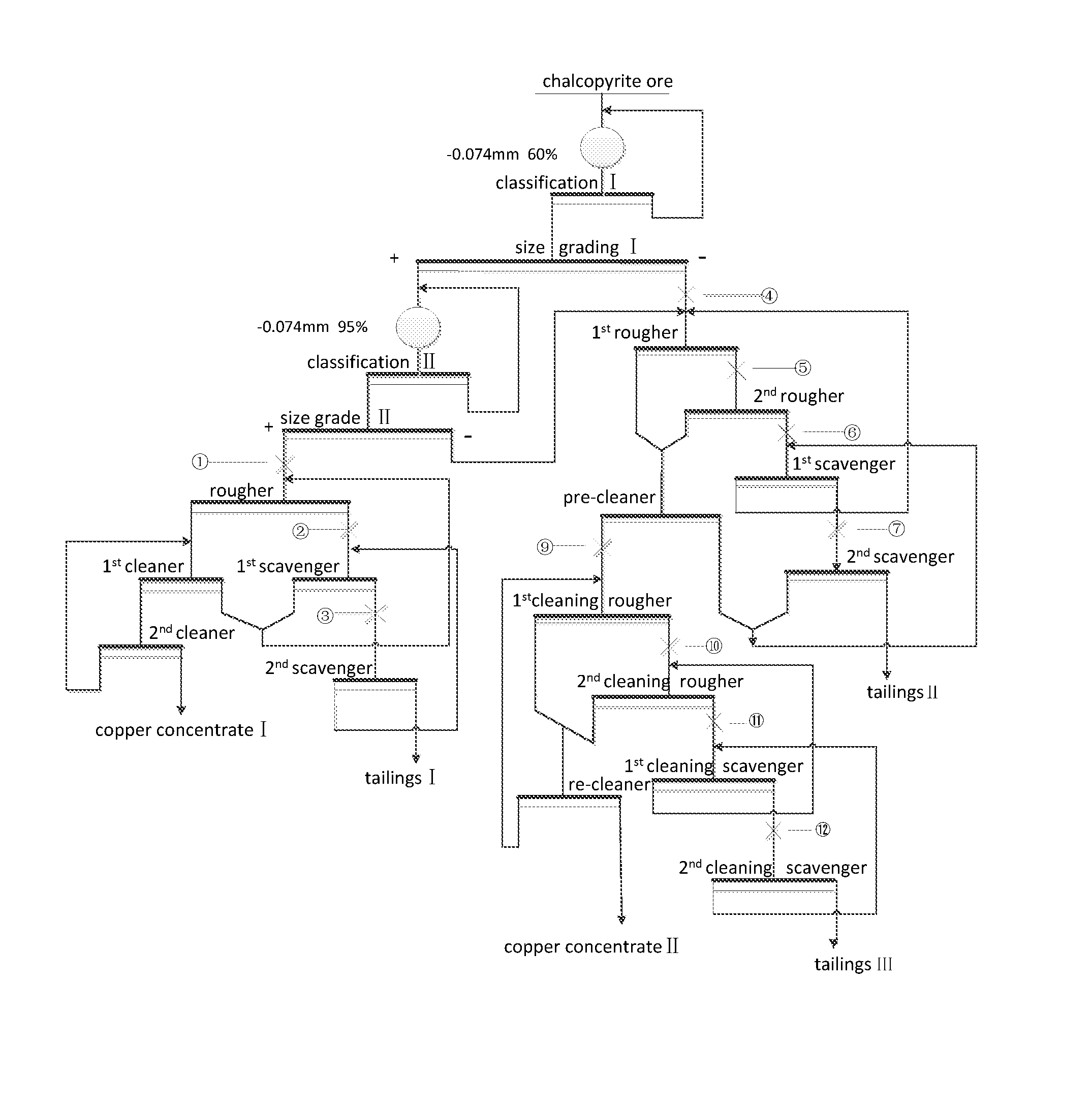Chalcopyrite ore beneficiation process and method
a technology of chalcopyrite and beneficiation process, which is applied in the direction of flotation, solid separation, grain treatment, etc., can solve the problems of difficult to obtain a steady metallurgical performance, adverse to the sequential tailing treatment and the environment, and extremely toxic sodium cyanide reagents, etc., to reduce the consumption of reagents, reduce the influence, and reduce the influence
- Summary
- Abstract
- Description
- Claims
- Application Information
AI Technical Summary
Benefits of technology
Problems solved by technology
Method used
Image
Examples
example 1
[0011]Primary materials of the present invention: copper ore from Dongguashan, calcium oxide, CMC, sodium ethylxanthate, kerosere, pine camphor oil.
[0012]The chalcopyrite primary ore used in the present invention mainly contained 0.94% Cu, 23.20% TFe, 14.38% S, 3.9% MgO, 28.03% SiO2, and the principal mineralogical composition were sulfide minerals (including 24.75% pyrhotite, 10.71% pyrite, 3.07% chalcopyrite, 0.01% galena, etc), 8.07% iron oxide (mainly comprising magnetite), and gangue mineral (consisting predominantly of 7.49% quartz, 4.34% feldspar, 1.5% talc and 6.22% carbonate, etc). The dissemination of chalcopyrite and pyrrhotite was relatively fine in the ore, whereas pyrite was mainly disseminated in the coarse fraction, and the relationship amongst the dissemination of these three minerals was very complex, so that optimum liberation was seldom achieved, which has significant impact on grinding stage and the sequential floating circuits.
Step One: Size Grading
[0013]The cr...
example 2
[0018]The operations were similar to those in example 1. The reagent amounts and mixing time of each operation are shown in Table 2 below.
TABLE 2CaOCMCXanthatePine camphor oilmixingmixingmixingmixingNumericalpHtimeamounttimeamounttimeamounttimeordervalue(min)(g · t−1)(min)(g · t−1)(min)(g · t−1)(min)111.42752752221211.52372372111311.5225225271911.927027522411011.926527022011111.923523721211211.9223225281KeroseneDiesel oilPine camphor oil——mixingmixingmixing——amounttimeamounttimeamounttime(g · t−1)(min)(g · t−1)(min)(g · t−1)(min)4402——101——5402——81——6202——51——7132——31——
[0019]After the flotation, copper concentrates (combining copper concentrate I and copper concentrate II) grading 21.12% Cu was obtained at recovery and yield of 91.3% and 3.89% respectively.
example 3
[0020]The operations were similar to those in example 1 with the exception that diesel oil was used as collector in the step (3) fine-grain flotation circuits.
[0021]The reagent amounts and mixing time of each operation are shown in Table 3 below.
TABLE 3CaOCMCXanthatePine camphor oilmixingmixingmixingmixingNumericalpHtimeamounttimeamounttimeamounttimeordervalue(min)(g · t−1)(min)(g · t−1)(min)(g · t−1)(min)111.62702752241211.52352372121311.5224225281912.026026022411011.926026522011111.823023021211211.8220220281KeroseneDiesel oilPine camphor oilmixingmixingmixingamounttimeamounttimeamounttime(g · t−1)(min)(g · t−1)(min)(g · t−1)(min)4——382915——382916——192417——12231
[0022]After the flotation, copper concentrates (combining copper concentrate I and copper concentrate II) grading 21.03% Cu was obtained at recovery and yield of 90.42% and 4.12% respectively.
PUM
| Property | Measurement | Unit |
|---|---|---|
| size | aaaaa | aaaaa |
| size grading | aaaaa | aaaaa |
| flotation time | aaaaa | aaaaa |
Abstract
Description
Claims
Application Information
 Login to View More
Login to View More - R&D
- Intellectual Property
- Life Sciences
- Materials
- Tech Scout
- Unparalleled Data Quality
- Higher Quality Content
- 60% Fewer Hallucinations
Browse by: Latest US Patents, China's latest patents, Technical Efficacy Thesaurus, Application Domain, Technology Topic, Popular Technical Reports.
© 2025 PatSnap. All rights reserved.Legal|Privacy policy|Modern Slavery Act Transparency Statement|Sitemap|About US| Contact US: help@patsnap.com


